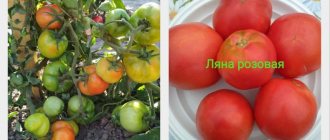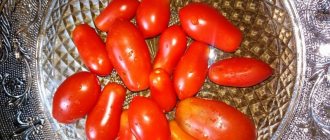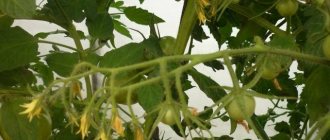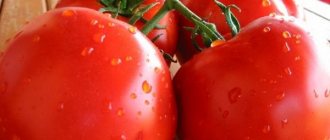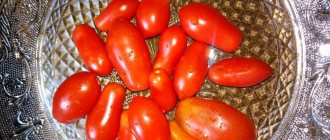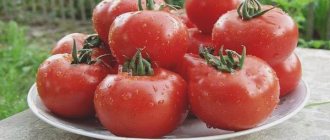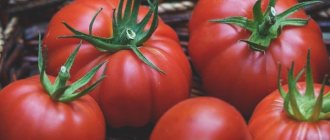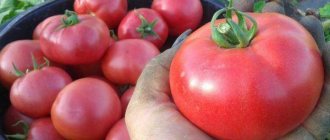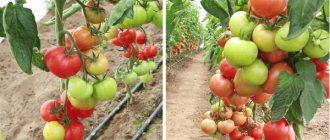The Moscow delicacy tomato has an amazing taste. Tomatoes of this variety are delicious in fresh salads. They make delicious pickles and marinated preparations. Add to hot dishes and make ketchup.
| Height | Landing location | Ripening time | Fruit color | Fruit size | Origin | Fruit shape |
| Tall | Greenhouse, Open ground | Mid-season | Reds | Average | Variety | Pepper-shaped |
Description of the variety, reviews, photos
Mid-season, indeterminate, productive variety of tomatoes.
Recommended for growing in the middle zone in a greenhouse, in the southern regions in open ground with a garter to a support. The period from germination to the beginning of ripening is 120-125 days. The bush is powerful, up to 1.8 meters high. The best results were obtained when forming a plant with 2 stems. With this forming method, all stepsons are removed, except for one growing under the first flower raceme.
The leaves of this tomato are large and green. The inflorescence is simple and intermediate. The first inflorescence is laid above the 9-11th leaf, the subsequent ones - every 3-4 leaves.
Fruit characteristics
The fruits are pepper-shaped, dense, beautiful, red in color at maturity, weighing 80-150 grams, fleshy, good taste. These tomatoes are universal in purpose - good fresh and excellent in pickling; they are also suitable for making juices, sauces and purees. They have good presentation and transportability.
The variety is moderately resistant to tomato diseases.
Productivity : up to 6 kg of fruits per 1 square meter of planting (subject to agricultural practices).
Value of the variety : high yield, original shape of fruits and their excellent taste.
The Moscow delicacy tomato variety is included in the State Register of the Russian Federation for garden plots, homesteads and small farms for cultivation in open ground.
Features of cultivation
Sowing seeds for seedlings is carried out 60-65 days before the intended planting in the ground. Dive - at the stage of 2 true leaves. When planting seedlings in a permanent place per 1 sq. It is recommended to place up to 4 plants per meter.
Further care for tomatoes consists of timely watering (we recommend using drip irrigation), fertilizing with complex mineral fertilizer, pinching, weed removal and preventive measures to protect plants from diseases and pests.
How to grow seedlings
Sowing seeds for seedlings begins 2 months before planting in the ground. Before sowing, planting material undergoes mandatory preparation.
Seed preparation
Seeds are carefully checked for visible defects: damage, distortion. The dark color of a seed indicates its non-viability; only light-colored seeds are suitable. Next, the seed is checked for emptiness inside. To do this, dissolve 1 teaspoon of salt in 1 glass of water and place the grains in it. Those suitable for sowing remain at the bottom of the glass.
After this, the grains are disinfected in a weak solution of potassium permanganate for 20 minutes. Then rinse with running water and dry. After disinfection, only viable specimens remain that are capable of producing strong shoots.
To improve germination, seeds are soaked for 12 hours in a growth stimulator or in melt water and aloe juice.
Container and soil
The soil is prepared from garden soil, peat, river sand and wood ash. All components are thoroughly mixed, after which the resulting mixture is disinfected by steaming in the oven for 15 minutes at a temperature of 50-60°C.
For disinfection purposes, the prepared soil can be spilled with a hot solution of dark potassium permanganate. This procedure is necessary to destroy pathogenic flora, which ensures further healthy growth of seedlings.
Fill the planting containers halfway with the prepared soil, after making small drainage holes at the bottom. The remaining soil is poured into containers as the seedlings grow. This technique ensures additional receipt of useful substances during the seedling period.
Place in a common wooden box or individual container. Sowing in separate containers further reduces seedling care to a minimum.
Sowing
Seed material is sown to a depth of 1.5-2 cm with a distance of 2-3 cm from each other. Sprinkle the top with earth, level it, lightly moisten it with warm, settled water and cover the containers with film or glass to create a greenhouse effect.
The planting container is left in a bright and warm room at a temperature of at least 25°C. Before germination, the film is periodically removed and the top layer of soil is moistened as it dries out.
Further care of seedlings
When seedlings appear, the containers are moved to the windowsill, but not to direct sunlight. Daylight hours for seedlings are 15-16 hours, so there is a need for additional illumination with phytolamps. With insufficient lighting, seedlings are stunted in growth.
Water moderately, without flooding the sprouts, with warm, settled water using a shallow watering can. After watering, the soil is carefully loosened, thereby ensuring better penetration of oxygen to the young roots.
When 3-4 true leaves appear, the seedlings dive and are planted in separate containers. If the seeds are sown in individual containers, picking is not required. The picking procedure involves removing the main root by one third. This technique leads to the growth of lateral roots, resulting in the formation of a powerful root system.
2-3 weeks before transplanting, seedlings begin to harden by taking the seedlings out into the open air for 1 hour at a temperature of 16-17°C. Gradually the time interval is increased to 12-13 hours. Simultaneously with daytime hardening, the night temperature is reduced to 12°C.
Tomatoes Moscow delicacy, video
In Russia, seeds of this variety are produced.
If you grew Moscow delicacy tomatoes, please write whether you liked them or not. What was the yield and taste of the fruits like under your climatic conditions? How do you rate the disease resistance of this variety? If possible, attach a photo of the entire bush or individual fruits you grew to your comment. Thank you!
Your reviews of the Moscow delicacy tomato and additions to the description will help many gardeners evaluate this variety more objectively and decide whether it is worth planting or not.
Advantages and disadvantages
Almost everyone who has planted the Moscow delicacy claims that this variety has many advantages in comparison with other varieties of tomatoes.
The main advantages of tomatoes include the following:
- long duration of fruiting;
- resistance to common tomato diseases;
- large and juicy fruits;
- ease of care when growing;
- the ability to collect 2–3 kg of ripe fruits from one bush.
Due to the above advantages, this variety is popular among vegetable growers. However, despite all the advantages, the Moscow delicacy has two disadvantages:
- rotting of ripened tomatoes due to waterlogged soil;
- the appearance of blossom end rot when bushes are close together.
Characteristics of the Moscow Delicacy variety
Seed producers often, as a result of breeding experiments, obtain several plants with specified parameters, but with a number of differences.
The “Moscow delicacy” series includes tomatoes with red and striped fruit, and the hybrid tomato Moscow delicacy creamy F1 – yellow in color. They have the same, pepper-shaped fruit shape, all without exception are high-yielding, with average ripening periods. Tomatoes differ in color and some taste characteristics. Description of the variety and characteristics:
- The variety is tall, belongs to the category of indeterminate, reaches a height of 140-190 cm;
- the plant intensively grows green mass from side shoots and large leaves;
- forms inflorescences of simple and intermediate types, the first is formed above the level of the ninth leaf;
- the variety belongs to the category of mid-season with a growing season of at least 120 days;
- the productivity is very high. 4-6 kg of tomatoes are collected from the bush;
- fruits are two-chambered, elongated, pepper-shaped, red;
- striped “Moscow delicacy” tomatoes are dark red with brown-green stripes and splashes;
- Moscow delicacy cream tomatoes have a bright yellow, almost lemon-colored color and a beak-shaped tip;
- tomatoes have a sweet tomato flavor with peppery notes. Very fragrant. Weight from 80 to 150 g;
- fruits do not lose their presentation for up to 1.5 months after harvest and tolerate transportation well;
- used for fresh food and canning (pickling, pickling, tomatoes in their own juice, lecho, puree, salads). Reviews speak of the excellent quality of dishes and winter preparations.
Read also: Watermelon - Ogonyok: description of the variety, cultivation, reviews
“Moscow delicacy” and all its variants belong to the category of heat-loving, tall plants that are grown in greenhouses with the obligatory tying of stems. Successful cultivation of the variety in open ground conditions can only be done in the southern regions.
Important! At the initial stage, tomato seedlings need to adhere to a day and night regime. Additional lighting during the day and a decrease in night temperatures by 5-6 degrees will prevent plants from stretching out and getting sick.
Variety specifics
The Moscow Delicacy tomato is a mid-season variety. The first shoots ripen at 110-120 days. The bushes bear fruit for quite a long time. As a rule, many gourmet varieties are very capricious and often susceptible to diseases, which cannot be said about the Moscow variety. Tomatoes do not require special treatment with preventive chemicals. When growing this variety, gardeners rarely encounter fungal and viral diseases.
The advantages of the variety include the following:
- disease resistance;
- high productivity;
- excellent taste;
- versatility;
- ease of cultivation.
The tomato bush is quite powerful. The average height of the crop is 150-180 cm. The bush is tall and needs to be tied up. Anyone who has already planted this variety knows that the plant, due to its power, does not need feeding.
The leaves of the bush are large and green. There is a lot of foliage, regardless of the frequency of watering. A distinctive feature of this variety is that each subsequent fruit is larger than the previous one, while with ordinary varieties of tomatoes everything is just the opposite.
The tomatoes are cylindrical or pepper-shaped and slightly ribbed. The fruits are dense and taste like bell peppers. The green tomato has a dark green color and a black stalk. When ripe, the fruits are red. The pulp is not watery, thanks to which the tomatoes are stored for a long time. The taste is excellent. The average weight of the fruit is 90-160 g. With proper care, about 5-7 kg of tomatoes can be harvested from 1 m².
This variety has a high sugar content, so it is often used to make baby purees. Tomatoes can be eaten fresh and used for pickling. The pickling delicacy retains its shape and does not burst during processing.
Many varieties of tomatoes burst during heat treatment. You won’t encounter such a problem with the Moscow delicacy. Stuffed tomatoes do not crack and retain their shape perfectly.
Growing and caring for the variety
Varietal characteristics, their characteristics and descriptions form a number of rules, without which it is difficult to obtain a decent harvest.
We grow seedlings
The quality of seedlings grown in compliance with the regime of day and night temperatures, lighting, dosed watering and fertilizing will become a reliable guarantee of a good harvest.
- Seeds begin to be planted for seedlings 60-65 days before the planned planting in the greenhouse. This is mainly the month of March. The date largely depends on the climatic conditions of the region and the quality of the greenhouse shelter.
- Seeds are prepared by disinfection in a manganese solution and treatment with a growth stimulant.
- Planted in moist soil, deepened by 2 cm. Germination should be expected after 5 days.
- Plants pick up when the first true leaf appears, planting them in separate containers.
- Seedlings require moderate watering and fertilizing. At the initial stage, especially in cloudy weather, lighting is required to prevent the stems from stretching.
For those who have planted tomatoes more than once, these rules will not seem too complicated. But they shouldn’t be ignored either. By observing the day and night regimes and moistening the soil in time, you can get high-quality healthy seedlings, ready for any load.
A feature of indeterminate varieties is intensive, almost unlimited growth. It is necessary to pay attention to the correct formation of the bush: removal of side shoots, excess foliage and timely limitation of stem growth.
Replanting the tomato to a permanent location
There are no special secrets in the agricultural technology of growing the Moscow Delicacy tomato variety.
- Seedlings are planted in the greenhouse in May. The recommended layout is 70 x 50 cm, which is approximately 3-4 plants per square meter.
- We grow tomatoes by tying them to trellises or vertical supports.
- As it grows from the bottom of the stem to a height of 60-80 cm, the leaves are removed. This measure improves air exchange, prevents the spread of fungal diseases, and does not distract the plant’s strength from the main task - the formation of ovaries.
- The bush is formed into 2-3 stems, leaving 4 to 7 ovaries on each. After the required number of brushes is formed, the crown of the plant is pinched.
- Water the bushes with warm water, at the root. It is especially necessary to monitor the soil moisture at the time of flowering and intensive growth of tomatoes.
- Care comes down to watering, loosening the soil, fertilizing, removing stepsons and yellowed foliage.
- The harvest begins in July and August.
- With the onset of cold weather, they monitor the plants, trying to identify possible diseases in time. The variety can be affected by nematodes and late blight.
The presented description of agrotechnical techniques allows you to understand the main stages of plant care. Of course, every gardener has his own secrets for getting a good harvest. Someone thinks that if I planted tomatoes in a greenhouse, then I should use its entire volume. Let them grow to the very top. This practice is suitable for this variety.
Even on the street, “Moscow Delicacy” forms ovaries well, especially in hot weather. What can we say about greenhouse conditions? But tomatoes must have time to grow at least to a state of technical maturity. This must be taken into account in short summer conditions. Otherwise the variety is very productive. Housewives are happy with it and enjoy using it in home cooking.
Growing rules
Reviews of the Moscow delicacy tomato describe it as an unpretentious crop that maintains productivity even with minimal care. But some activities are mandatory, without them you can’t count on a good return.
An important stage in growing tomatoes is the preparation of planting material. The quality of the seedlings determines how easily the tomatoes will take root in a permanent place and how quickly they will begin to grow.
Planting seedlings
To be confident in the quality of planting material and the variety of tomatoes, experienced gardeners try to grow all the seedlings themselves. The timing of sowing seeds is calculated so that the time of planting falls on the 60th–65th day.
For greenhouse tomatoes, the main rule for growing seedlings is sterility. Disinfect containers for planting, soil, and the seeds themselves (with a weak solution of potassium permanganate). The soil for the Moscow delicacy is the same as for all tomatoes: loose, fertile, with an admixture of peat, sand and wood ash.
When growing seedlings, you should follow some rules:
- Do not bury the seeds more than 2 cm.
- After germination, provide the plantings with lighting.
- Do not over-water, but do not over-dry the plants.
- Dive after 2 or 3 true leaves.
Even before transplanting under film, tomato seedlings need to be hardened off. To do this, the soil is dried a little, and the plants are taken out into the open air for several hours a day.
Tomato transplant
It is worth moving tomato seedlings to a permanent place if the weather is stable and a confident +10 °C at night. The growth of the bushes requires the installation of strong supports for tying up adult plants with the harvest. It is better to take care of this before landing.
The recommended planting scheme for Moscow delicacy tomatoes is shown in the photo.
A feature of the seedlings of tall tomatoes of the Moscow Delicacy variety, according to reviews, is its ability to stretch out and outgrow. Such tomatoes are planted reclining (at an angle of up to 45 °) or buried to the very leaves.
The Moscow Delicacy variety does not require intensive feeding. For stable fruiting, it is enough to standardly treat, disinfect and fertilize the soil in a greenhouse or garden bed. For varieties moderately resistant to late blight, the addition of wood ash before planting is a necessary preventive measure.
Subsequent care for tomatoes
Moderate but sufficient watering of Moscow Delicatessen can be easily achieved using drip irrigation systems. Mulching with plant residues or peat protects the soil from drying out and reduces the amount of weeding and loosening of tomatoes.
Advice! With any irrigation system, you should not over-moisten the soil under tomatoes. In a greenhouse, this threatens the development of fungal infections even in varieties that are immune to diseases.
The decisive influence on the yield of the Moscow gourmet tomato, according to reviews and photos of experienced gardeners, is the way the bush is formed. Experts advise leaving two main stems, avoiding thickening. To do this, remove all the stepsons except the one located under the first flower brush. Thus, from the beginning of the development of the tomato bush, there will be two strong shoots on which the main crop is laid.
Further formation depends on growing conditions. If you want to limit the growth of the Moscow delicacy tomato, its top should be pinched at the desired height. A free-forming bush can grow more than 1.8 m. All side shoots and stepsons should be removed several times a season.
The leaves on the bushes of this variety grow densely, regardless of fertilizing and watering. The lower part of the tomatoes should be freed from greenery completely up to the first ovary. Leaves located above are removed as needed, exposing the ripening tomatoes to light.
The Moscow Delicacy variety has powerful shoots, but the height of the bush and the abundance of the harvest require support. The tomatoes are tied several times, fixing the growing stems, supporting large bunches of tomatoes.
Tomato “Moscow delicacy” with an extended fruiting period
Today there are a huge number of tomato varieties in the world, but breeders do not sit idle and develop new ones. You can choose any of them for growing on your personal plot, but it is very difficult to understand all the diversity. Gardeners' requirements for tomatoes remain unchanged: fairly high yields, ease of care, resistance to diseases and, of course, excellent taste. The Moscow Delicacy tomato variety can successfully meet most of the above criteria.
The nuances of breeding in open ground and in greenhouse conditions
Indeterminate types do not have a growth limit . It is for this reason that the tops are pinched, otherwise the bushes, with further growth, will spend nutrients on unnecessary green mass, and not on the formation of fruits.
Removing the lower leaves helps to ventilate the plants and soil in the holes. This important factor prevents the development of fungal spores.
Watering with cold water is detrimental to the crop. The water must be warm and settled. To do this, barrels are installed in the garden plot, which are filled 2-3 days before watering. During this time, the water has time to warm up in the sun.
Water in the evening or in the morning to prevent the leaves from getting sunburned. Moderate watering, proper plant formation and soil fertility have a positive effect on fruiting.
Appearance and description of the variety
This variety is included in the State Register of the Russian Federation for the purpose of growing in open soil in gardens and household plots and in small farms. It is better suited for the southern regions; “Moscow Delicacy” can be grown in greenhouses. This is a variety with an average ripening period; approximately 120 days should pass from the first shoots to the appearance of ripe fruits.
Read also: Treatment of potatoes before planting against the Colorado potato beetle: procedure and features
The “Moscow Delicacy” tomato variety has an average yield. Its bush is indeterminate, powerful, and can reach a height of slightly less than two meters, so the bushes must be tied to a support, and some gardeners pinch them. The plant performs best when formed into two stems; in this case, you need to remove all the stepsons that appear, except for the one that grows under the first flower cluster.
Fruit characteristics
The fruits of tomatoes have a beautiful pepper-shaped shape, elongated, with a pointed tip. They are dense, meaty, tasty, but do not have a high level of juiciness. Unripe tomatoes are dark green in color with lighter stripes. Ripe fruits are bright red. Their skin is quite dense and glossy, which contributes to the excellent preservation of tomatoes during transportation and their long shelf life. When describing the “Moscow Delicacy” tomato variety, you need to pay attention to the amazing feature of these tomatoes: the fruits of the first harvest are smaller than the tomatoes of the next harvests; the largest fruits can be collected from the last stage of harvesting.
The weight of the fruits is from 70 to 150 g each; in greenhouse conditions, their weight can reach 190 g. Each fruit contains few seeds. The tomatoes taste quite unusual, so to speak, not for everyone. They are sweetish and sour, with a pleasant, but not very tomato-like aroma. Many who have tried the “Moscow Delicacy” note that the taste characteristics of these tomatoes are more reminiscent of peppers rather than tomatoes.
Advantages and disadvantages of the variety
Moscow Delicacy tomatoes have a fairly impressive number of advantages, but they also have some disadvantages.
The advantages and disadvantages of this variety over most other tomatoes include:
- the original and unique shape of medium-sized fruits in the form of a mixture of pepper and plum, elongated, with a sharp curved tip;
- extraordinary taste properties, also reminiscent of the taste of pepper;
- good yield;
- unpretentiousness of plants;
- with each subsequent stage of harvesting, the fruits weigh more and more (the first tomatoes from each bush are the lightest, the last ones are the heaviest);
- if you do not carry out special formation of the bush, then pinching of plants is not required;
- available for cultivation both in open soil and in greenhouses;
- quite resistant to late blight and other fungal infections;
- do not crack during heat treatment, excellent for canning and pickling.
Disadvantages of Moscow Delicacy tomatoes:
- significant height of plants, they need to be tied up, attached to a support;
- not everyone likes their taste.
Harvest and storage
Tomato fruits are collected at different stages of their ripening, since it all depends on the purpose of collecting the tomato. Most often, people who grew this variety collect reddened fruits. They are used for pickling and making pickles. Some people prefer to pick tomatoes that are still green, which are often added to canned dishes. The advantage of unripe fruits is their shelf life. They keep unchanged much longer than red tomatoes.
See also
Description of the tomato variety Sugar Bison, recommendations for cultivation and care
Read
Only large fruits that do not have visible damage on the surface are selected for storage. If they break off along with the stalk, the harvested crop is placed with its nose down. No more than 10–12 kg of tomatoes are placed in each storage container. If you put more tomatoes, they will begin to press hard on each other and because of this they will quickly spoil.
You can use plastic boxes or cardboard boxes as storage containers. It is recommended to lay several layers of paper at the bottom of containers for storing fruits so that they last longer and do not spoil.
Agricultural technology
“Moscow Delicacy” tomatoes are suitable for growing if the gardener is a fairly busy person or does not want to overwork himself on his plot. The process of growing this variety does not cause practically any hassle, it is not at all complicated, and half of the procedures required for other varieties of tomatoes are not necessary.
Preparing and planting seeds
The process of preparing seeds begins at the end of the last season, when seeds are removed from a ripe healthy vegetable, left for several days to ferment, washed and dried. Shortly before sowing for seedlings, healthy and high-quality specimens must be selected from overwintered dried seeds; this can be done by mechanical selection, as well as using a four percent saline solution, in which healthy seeds should sink to the bottom and poor-quality seeds should float. It would also be a good idea to check the seeds for germination; this test is carried out using a damp cloth or a dampened roll of paper, in which, among a certain number of seeds, some part must germinate; if the indicator is at least fifty percent, then such seeds are suitable for sowing .
Also, in order to obtain a high-quality and abundant harvest, the seeds must be disinfected with a solution of potassium permanganate; it would not be superfluous to carry out the process of panning, in which the seeds are enveloped in useful nutritional minerals with adhesive properties. Closer to the planting date, the seeds are heated to approximately 60°, germinated in damp gauze or other fabric and hardened by alternately placing them in the refrigerator and again at room temperature. Before planting, the seeds need to be soaked.
Read also: Bashkir giant currant: description of the variety, photos, reviews
You need to sow seeds for seedlings approximately 60 days before planting the seedlings in open soil or in a greenhouse. To do this, nutritious soil is prepared in advance and the seeds are sown at a depth of about a centimeter or a little more; they must also be watered and this continues to be done periodically until sprouts appear.
Seedlings and planting in the ground
Before planting in the soil, it is recommended to feed the seedlings and harden them; after such processes are carried out correctly and competently, the yield and quality indicators of the Moscow Delicacy tomatoes will be much higher. When the weather stabilizes and the threat of frost has passed, tomato seedlings can be planted in open fertilized soil. Since this is a tall variety, it is recommended to plant plants at a density of four bushes per square meter of area.
Near each bush it is necessary to install a peg to support and tie up the tomatoes during growth. When planting a plant, you must not forget to water it; additional fertilizing with organic and mineral substances will also not be superfluous.
Care and watering
Caring for Moscow Delicacy tomatoes includes:
- regular watering, preferably by drip method;
- periodic fertilizing with a complex of mineral fertilizers (although this variety feels good without any fertilizing);
- pinching (especially if it is necessary to form a bush);
- loosening the soil and destroying weeds, which pose a particular threat to Moscow Delicacy;
- carrying out preventive measures to combat diseases and pests dangerous to tomatoes.
It is better to grow this variety when formed into two bushes. From the bottom of the stem of these plants, you need to remove almost all the leaves for better ventilation and air flow. It is recommended to water tomatoes quite often not with cold, but even with lukewarm water. The “Moscow Delicacy” variety is quite unpretentious in care; even a beginning gardener can successfully grow it, because after planting the seedlings in a permanent place, it only needs special attention when it is watered or harvested.
Pests and diseases
This variety is moderately resistant to diseases typical of tomatoes. “Moscow Delicacy” tomatoes have special immunity to late blight: even when this disease is raging, tomatoes do not succumb to its negative effects. Other fungi can affect them, but this is quite rare.
A particular danger for this variety is the root-knot nematode, an insect that, penetrating through the roots into tomato stems, lays larvae that are toxic to tomatoes. The bushes then become covered with tubercles—“houses” for the larvae—and gradually die off. It is very difficult to destroy such a pest, so all that remains is to remove the bushes that it has infected and disinfect the ground. An excellent way to repel such a scourge is garlic planted next to the tomatoes.
Harvesting
The “Moscow Delicacy” tomato harvest ripens in medium terms; from the emergence of seedlings to the first ripe tomatoes, it takes up to 120 days. From one square meter of plantings you can get up to 6 kg of fruit, and with proper adherence to agricultural technology and favorable weather and climatic conditions, it is possible to collect up to 4 kg from one bush. The fruiting period of these tomatoes is quite long and uniform.
How to grow tomatoes
After 2 months, the seedlings are ready to be transplanted to a permanent location. Tall tomatoes usually overgrow during the seedling period, reaching 40-45 cm in height. This important feature does not allow the bushes to be planted vertically, so they are placed in a reclining hole.
Landing
Planting pattern: 50 cm – distance between seedlings, 70 cm – row spacing. For 1 sq. m place 3-4 plants.
The crop is replanted in the evening or early morning, when the sun is not at full strength. Only planted tomatoes do not like direct sunlight, so it will be difficult for them to adapt to new conditions under unfavorable factors.
The holes are made in advance with a depth of 20 cm, first watered generously with warm water. After transplantation, the young bushes are watered again with warm water, the soil is compacted and left to get used to constant conditions for at least 8 days.
Regular watering is established as the seedlings adapt. Water no more than 2 times a week, but during flowering and fruit formation, the crop requires more moisture. Watering is also increased during hot and dry days. Water only with warm, settled water, at the roots of the plants, without getting on the leaves.
Attention ! Cold water has a detrimental effect on tomatoes. They stop growing and developing.
After watering, the beds are loosened, removing all weeds with roots. Many insect pests breed in weeds, so it is necessary to clear the beds of unnecessary plants. Weeds can be used as mulch; when rotting, they enrich the soil with many useful substances. Straw or peat is also used for mulch. Mulching retains moisture in the beds longer.
Features of care
Particular attention should be paid to the crop during the flowering and fruiting period.
Fertilizer and watering
Watering is carried out regularly, focusing on the top layer of soil that has dried up to 15 cm. The water should be warm and settled. Water at the root; water should not get on the foliage. It is best to carry out the procedure in the evening, when the sun is not so active.
According to reviews from vegetable growers who planted this variety, it does not need frequent feeding. It is enough to fertilize with organic matter at the stage of active growth (for example, mullein solution - 0.5 l per m2). During the flowering and fruiting period, they are fed with mineral complexes containing potassium and phosphorus approximately once a month. Use “Universal” or “Solution” preparations for fertilizer in the dosage specified in the instructions.
The meaning of the number 3 (Three) in numerology
Bush formation and pinching
The “Moscow delicacy” bush branches well, so you need to form it into 2-3 stems to avoid thickening. Pruning is carried out regularly, removing shoots that interfere with the established form. When tearing off a leaf, do not pull it up, as this can damage the stem. They cut off with a sharp movement to the side. The wound is treated with wood ash or crushed coal.
During fruiting, the bush is tied under the brush so that the shoot does not break under the weight of ripening tomatoes.
Loosening the soil and weeding
Loosening is carried out after watering and precipitation to a depth of 5-7 cm. The procedure saturates the soil with air and improves its structure. As a result, the roots absorb moisture and nutrients better.
To ensure that there is enough moisture and nutrition, weeds must be eliminated in a timely manner. Weeds thicken the bed, creating good conditions for the development of pathogenic microorganisms.
Possible growing difficulties
The plant is resistant to diseases, but there are cases of late blight. To prevent the appearance of the disease, the beds are sprayed with a solution of copper sulfate or Bordeaux mixture.
If a disease occurs, it is necessary to treat with fungicides, including:
- "Fundazol";
- "Thanos";
- "Fitosporin-M".
The crop is little susceptible to pests, but damage by root-knot nematodes does occur. You can prevent its appearance with the help of garlic by planting it between the rows. In order to notice the insect in time, you need to inspect the planting more often, because the bushes affected by it will have to be dug up and destroyed. You can fight the pest using the biological agent “Fitoverm”.
Bushes and leaves
The bushes are tightly covered with large embossed leaves of a classic tomato shape, the color is dark green. The highest yields are shown by bushes formed from 2-3 stems. The first fruit clusters are formed at a level higher than the location of the ninth leaf on the stem. The bushes are tall, so they require additional support: they are tied to vertical supports or a trellis.
Disease and pest control measures
The Moscow delicacy tomato variety has increased immune protection against various diseases. However, this does not exclude the need to take a number of preventive measures:
- before sowing seedlings, care should be taken to ensure that the soil and seed are well disinfected;
- Quite often, tomato bushes are parasitized by nematodes. When the first signs appear, you will need to immediately get rid of the affected plants;
- to prevent pest invasion, garlic should be planted nearby;
- Before planting, wood ash is added to each hole to prevent late blight.
Late blight
Also for tomatoes of the Moscow Delicacy variety, aphids and whiteflies pose a great threat. A soap solution is used against aphids, and in advanced cases, general insecticides are used. Plants with a pronounced aroma help against whiteflies: calendula, marigolds, lavender, and so on. Various traps are no less effective.
Planting plants in the ground
The timing of planting “Moscow Delicacy” is selected depending on the climatic conditions of the growing region. It is important to take into account that the warm season is enough to ripen a mid-season tomato variety. If there is no confidence, then the seedlings are planted in greenhouses or greenhouses.
For comfortable development of tomatoes, the planting scheme is maintained with parameters of 50 x 40, and the planting density should not exceed 3-4 bushes per 1 square meter. meter of bed area.
Tomato ridges should be located in lighted areas with good protection from the wind.
After an adaptation period, gourmet tomato seedlings are provided with regular care, which includes:
- Timely watering of tomatoes with warm water. It is good to reschedule this event for early morning or evening after sunset. Delicate plants do not like sunburn from water droplets.
- Removing leaves. The lower ones are removed so that the ground in the holes is also ventilated. This gives good air permeability to the tomato roots and proper plant development. In the future, all dead or outgrown lower leaves must be removed.
- Removal of weeds and loosening. Loosen the holes of tomatoes carefully so as not to damage the roots. After loosening, you can lay a layer of mulch.
- Mandatory timely tying up of grown tomato stems. In this case, you must be careful not to crush the stems, otherwise the bush can be easily injured.
The formation and fixation of the above-ground parts is also necessary to ensure that the bush does not break under the weight of the fruit. Be sure to carry out pinching and removal of side branches on the bushes of this tomato variety.
Feeding “Moscow Delicacy” tomatoes with complete mineral fertilizers and organic matter with mandatory alternation of compositions. Systematic preventive treatment of tomatoes with copper-containing compounds to prevent the spread of fungal infections.
fermilon.ru
Adviсe
Growing tomatoes, a Moscow delicacy, occurs in each region at its own time. Seeds ripen in an average amount of time, and therefore it is important to pay attention to weather conditions: temperature changes, although they will not kill the plant, can disrupt its growth or fruiting.
Seeds or seedlings do not require feeding. This is because the variety has a powerful bush and is able to withstand negative factors inside the soil. Experts recommend using a substance such as “Vympel”. It will allow the plant to form faster and accelerate the growth of seedlings.
Planting is carried out according to the following scheme: the depth of the hole should not exceed 2 cm, a distance of 40 cm should be maintained between rows, and 50 cm between holes.
Farmer reviews
Reviews about the Moscow Delicacy tomato variety are only positive. For many lovers of salad varieties, these tomatoes are their priority.
Maxim, Taganrog: “For a long time I chose a variety that does not require special care. I decided to opt for Delicatessen. The result was interesting. Tomato bushes are really unpretentious. They grow well, the fruits have an unusual taste, reminiscent of the taste of bell pepper. Overall, I liked it."
Nikolay, Vologda: “If you don’t want to take much care, but want to get a good and unusual harvest, your choice is the Moscow delicacy. I planted it and forgot. By the way, an interesting fact is that each subsequent fruit is larger. Thus, small tomatoes grow first, and then quite large vegetables.”


